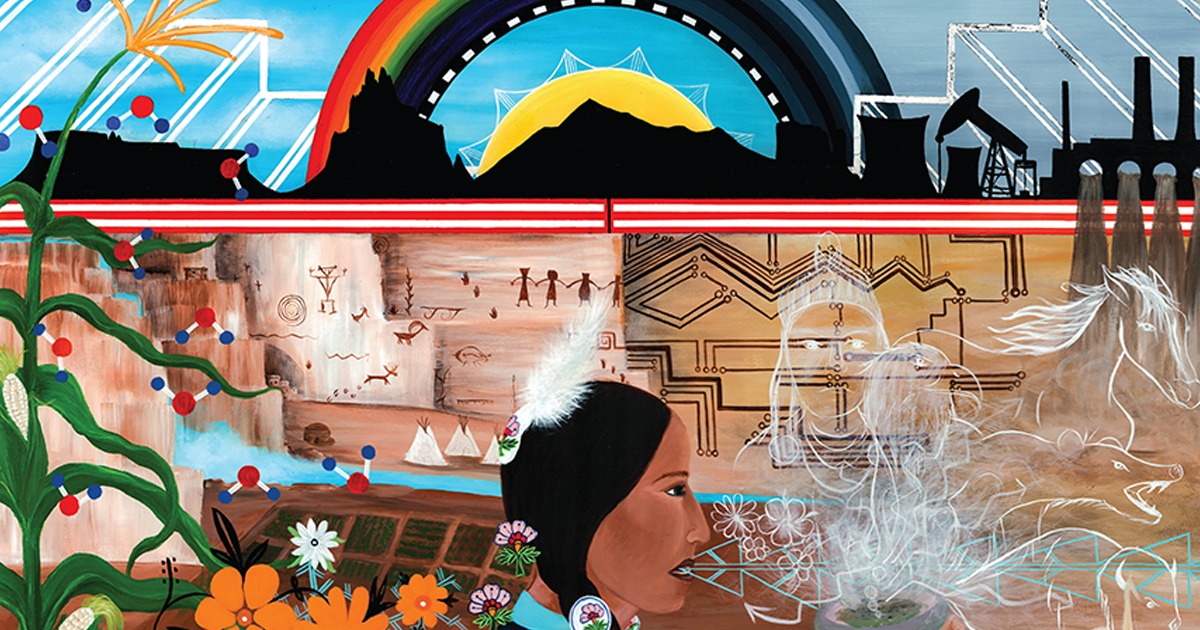NIEHS grantee’s art spotlighted for Native American Heritage Month
The NIH Tribal Health Research Office (NIH/THRO) featured the artwork of Zuni Pueblo artist Mallery Quetawki in its 2023 Native American Heritage Month poster. Quetawki created the “Healing Spirit” painting with support from the NIEHS Superfund Research Program at the University of New Mexico. The artwork depicts the impact of exposure to environmental toxins in the air, water, soil, and food and the strength and power of indigenous knowledge to heal and revitalize the earth. It is a reminder that the science of indigenous knowledges is powerful and should be promoted. The NIH THRO office selected the message of the artwork to highlight their theme, “Indigenous Knowledges Powering Science.”
To learn more about how NIEHS Superfund Research Program scientists worked with Quetawki to share research findings and public health messages with Native Americans, read this Environmental Factor story. Also check out Quetawki’s use of art to improve environmental health literacy in this grantee highlight. To learn more about the NIH Tribal Health Research Office, please visit the official website.
Test your home for radon this January

NIEHS recognizes January as National Radon Action Month, an observance led by the Environmental Protection Agency. Did you know that exposure to radon is the second leading cause of lung cancer after cigarette smoking? Radon, which is a naturally occurring radioactive gas that you cannot see or smell, moves up from the ground and can get trapped inside homes and buildings. Although radon is found in almost all indoor air, a radon level of 4 picocuries per liter (pCi/L) or higher is considered elevated.
To learn more about radon and to lower your exposure, check out the following NIEHS resources: radon factsheet, an Environmental Factor story, and a podcast. Also, find out where you can get a radon test kit to check levels in your home.
NIEHS scientists help harness data in Africa to solve health problems
In November, NIEHS scientists participated in the third Data Science for Health Discovery and Innovation in Africa (DS-I Africa) Consortium Meeting in Kigali, Rwanda. NIEHS partners with a dozen other National Institutes of Health institutes and centers, including the Fogarty International Center (FIC), to coordinate DS-I Africa. The NIH Common Fund Initiative aims to leverage data science technologies to transform biomedical and behavioral research and develop solutions to improve health. Research considering the impacts of climate change and health in Africa is of particular importance, noted Peter Kilmarx, M.D., acting director of FIC, the center that serves as the lead DS-I Africa coordinator.
During the consortium meeting, Bonnie Joubert, Ph.D., of the Population Health Branch, and Carol Shreffler, Ph.D., of the Exposure, Response, and Technology branch, helped lead a session titled “Opportunities to Harness Artificial Intelligence and Machine Learning for Health in Africa.” They respectively met with DS-I Africa grantees from the NIEHS co-funded HE2AT Center and the Advancing Public Health Research in Eastern Africa through Data Science Training project (APHREA-DST). Joubert and Shreffler also engaged with researchers leading two NIEHS- administered projects studying the effects of air pollution in combination with heat and other exposures on health outcomes in Africa.
For more information about the meeting, explore the DS-I Africa YouTube Channel.
George Lucier received North Carolina’s highest honor
In December, George Lucier, Ph.D., who directed the NIEHS Environmental Toxicology Program and co-edited the institute’s Environmental Health Perspectives journal, received the Order of the Long Leaf Pine. The Order, which is the highest civilian award North Carolina’s governor can make, was presented in recognition of Lucier’s many years of outstanding public service. Lucier retired from NIEHS in 2000 after a 28-year career at the institute, and he went on to serve in a number of local and state government positions related to environmental health and other topics.
Read more about Lucier’s career in this interview and EHP story, as well as his contributions to Central Carolina Community College.
(Caroline Stetler is Editor-in-Chief of the Environmental Factor, produced monthly by the NIEHS Office of Communications and Public Liaison.)
Source link
factor.niehs.nih.gov

